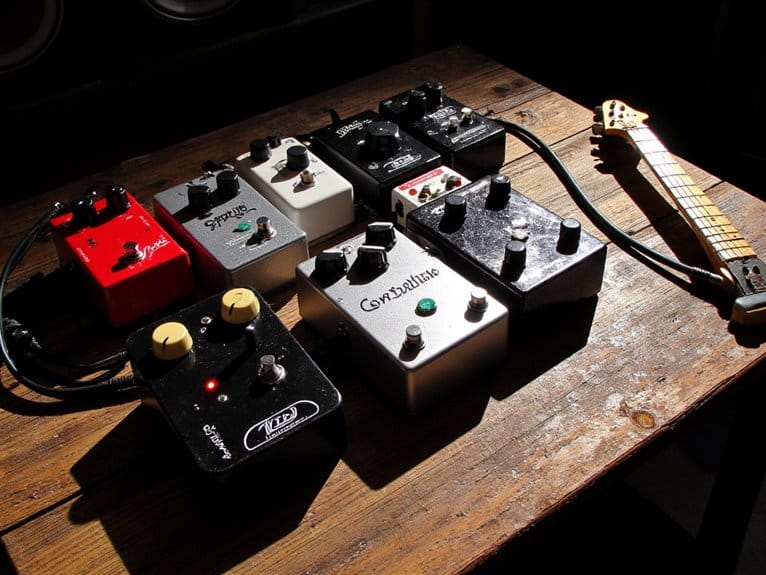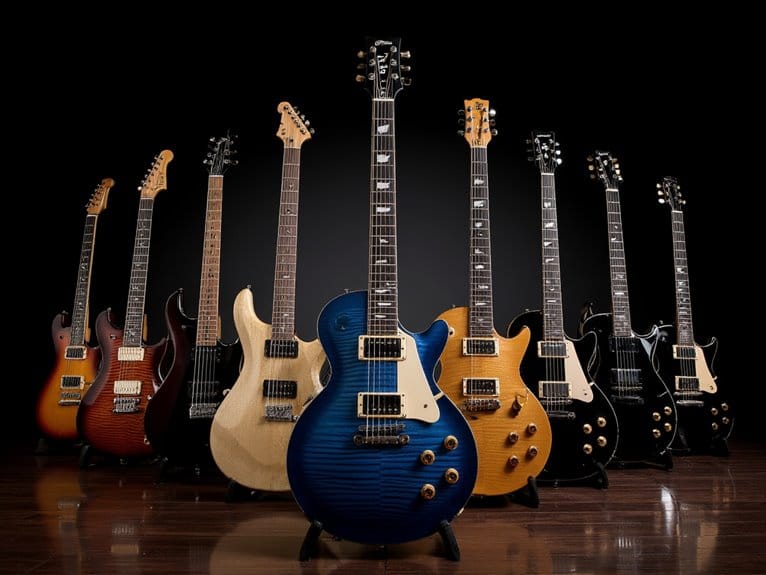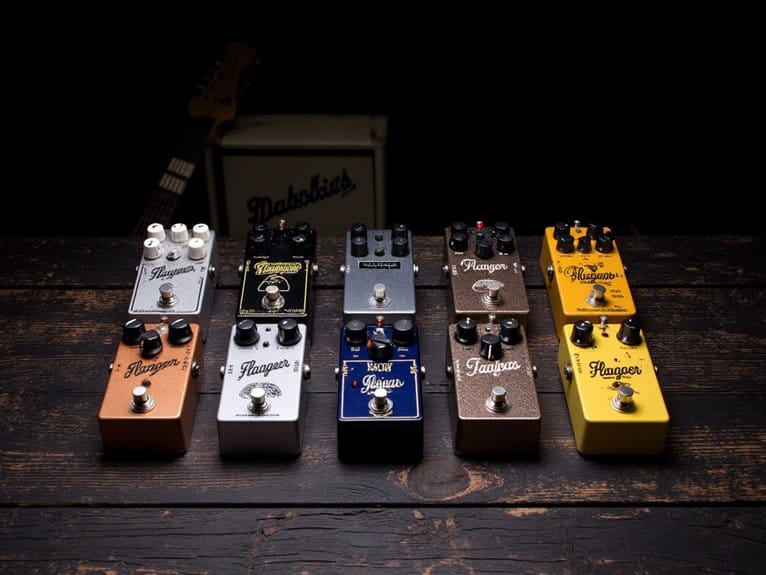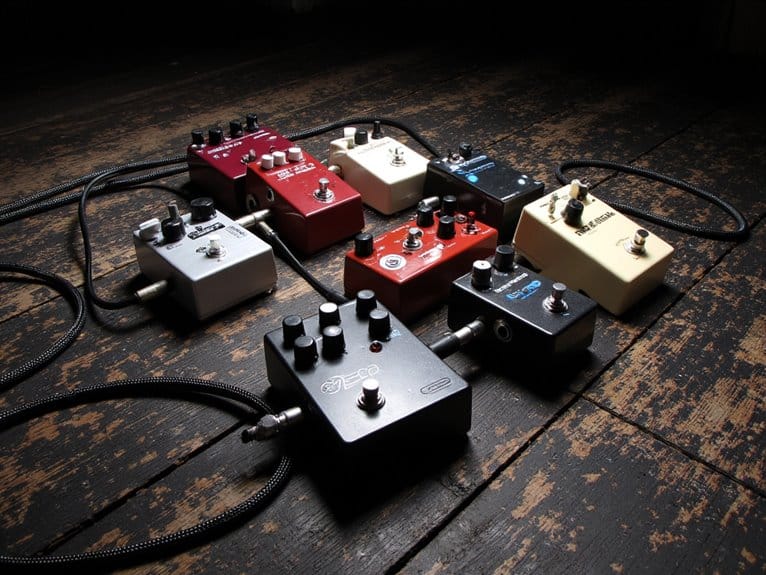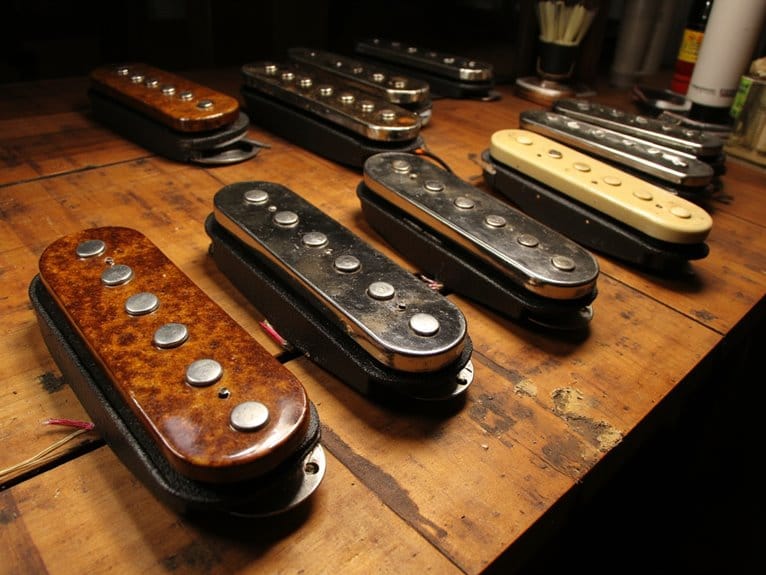10 Best Guitar Humidifiers to Protect Your Instrument Year-Round
I’ve found that two-way humidity systems like the D’Addario Humidipak Maintain Kit and MusicNomad Humitar ONE offer the best protection, automatically maintaining 45-50% relative humidity without constant refilling. Budget options like basic soundhole humidifiers work but require weekly attention, while premium models like the Oasis OH-5 provide superior moisture retention and hygrometer monitoring. Your choice depends on maintenance preferences and guitar value, though proper humidity control prevents costly repair bills that’ll explore below.
We are supported by our audience. When you purchase through links on our site, we may earn an affiliate commission, at no extra cost for you. Learn more.
Notable Insights
- Two-way humidity systems like D’Addario Humidipak automatically maintain 45-50% humidity without requiring regular refilling or monitoring.
- Soundhole humidifiers offer affordable protection but need frequent refilling, while advanced models provide maintenance-free, long-term solutions.
- Higher-priced humidifiers ($50+) include hygrometer functionality and superior moisture retention, offering better value than budget options.
- Proper placement following manufacturer guidelines ensures effective moisture distribution without obstructing sound quality or guitar performance.
- Quality humidifiers prevent costly humidity damage repairs, making them essential investments for guitar longevity in dry climates.
DAddario Guitar Humidifier System – Humidipak Maintain Kit
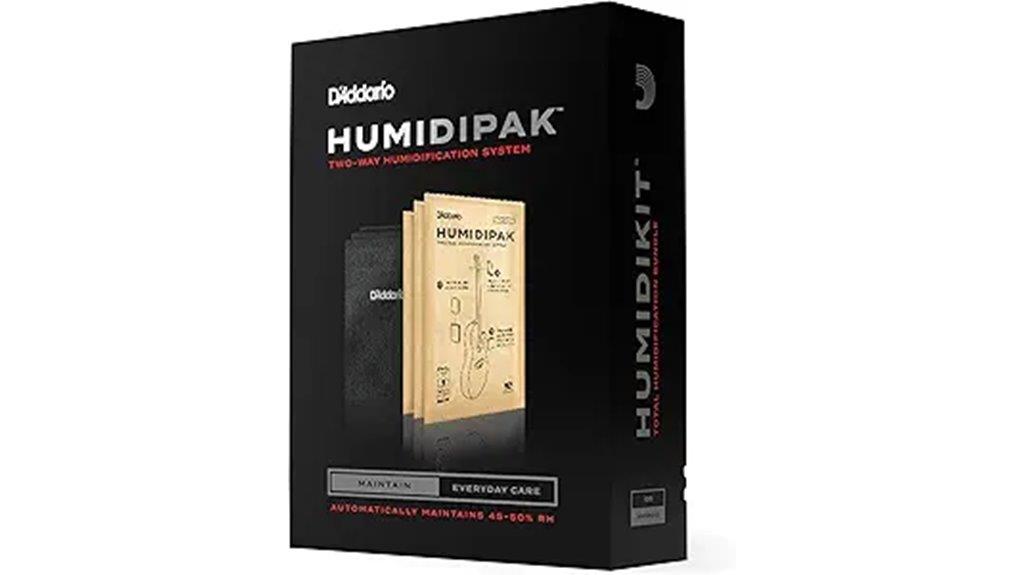
The DAddario Guitar Humidifier System stands as the only truly maintenance-free solution for guitarists who’ve grown tired of constantly refilling traditional humidifiers, automatically maintaining that essential 45%-50% relative humidity range without requiring any seasonal adjustments or manual intervention. Unlike conventional humidifiers that demand constant attention, this two-way system intelligently adds or removes moisture as your guitar’s environment dictates, effectively protecting against warping, cracking, and finish damage. Each kit includes three Humidipaks with a protective mesh pouch, lasting 2-6 months depending on storage conditions, making replacement straightforward with available refills when they become firm to touch.
Best For: Guitarists who want hassle-free humidity control without the constant maintenance and refilling required by traditional humidifiers.
Pros:
- Truly maintenance-free two-way humidity control that automatically adds or removes moisture without manual adjustments
- Long-lasting protection with each Humidipak lasting 2-6 months before replacement is needed
- Prevents costly guitar damage including warping, cracking, and finish deterioration
Cons:
- Requires ongoing purchase of replacement Humidipaks when they become firm, creating recurring costs
- Must be stored in sealed environments like hard-shell cases to maintain effectiveness
- Limited to 2-6 month lifespan per pack, meaning regular monitoring and replacement is still necessary
Martin Guitar Humidifier
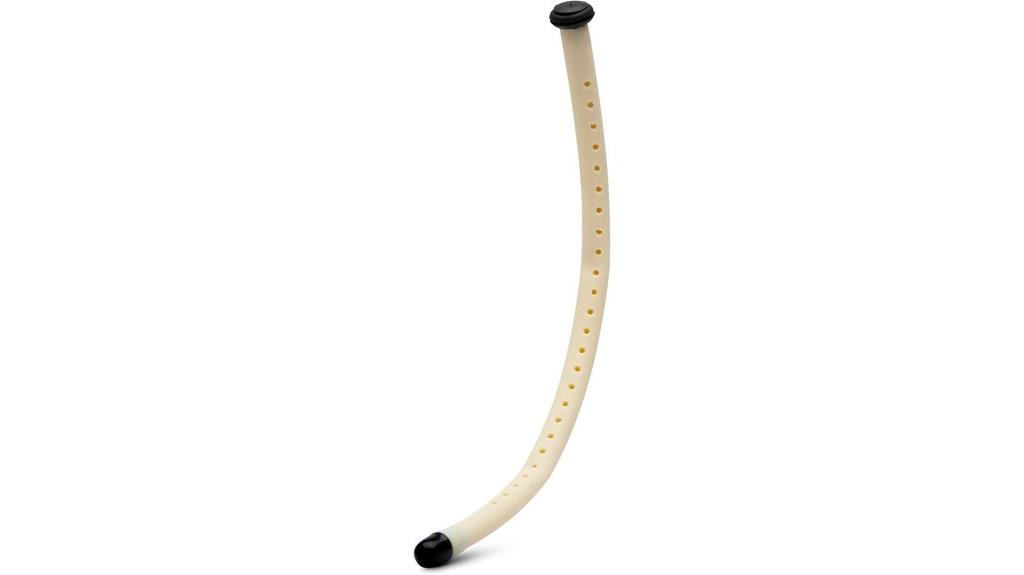
Martin’s guitar humidifier stands out as the premium choice for musicians who own valuable instruments and refuse to compromise on construction quality, featuring non-vinyl, non-allergenic resin materials that set it apart from cheaper alternatives. You’ll appreciate its thoughtful design that minimizes contact with your guitar’s interior, while the water suction stem delivers impressive moisture retention, absorbing ten times its weight in water for consistent humidity release through precisely engineered holes. Though it’s less flexible than competitors like DampIt, this sturdier construction actually improves durability and moisture control, making it particularly effective during winter months or extremely dry conditions when your valuable acoustic needs reliable protection.
Best For: Musicians with valuable acoustic guitars, mandolins, or other wooden instruments who need reliable humidity control during winter months or in extremely dry environments.
Pros:
- High-quality non-vinyl, non-allergenic resin construction with superior durability compared to more flexible competitors
- Excellent moisture retention capacity, absorbing ten times its weight in water for consistent, long-lasting humidity release
- Thoughtful design that minimizes contact with guitar interior and fits easily between strings without obstructing the sound hole
Cons:
- Less flexible than competitors like DampIt, which some users prefer for easier handling
- Requires careful attention to filling and monitoring to avoid over-humidification, necessitating a separate humidity monitor
- Sizing inconsistencies may cause fit issues with certain guitar models, and checking moisture levels can waste product capacity
MusicNomad HONE Guitar Hygrometer (MN312)
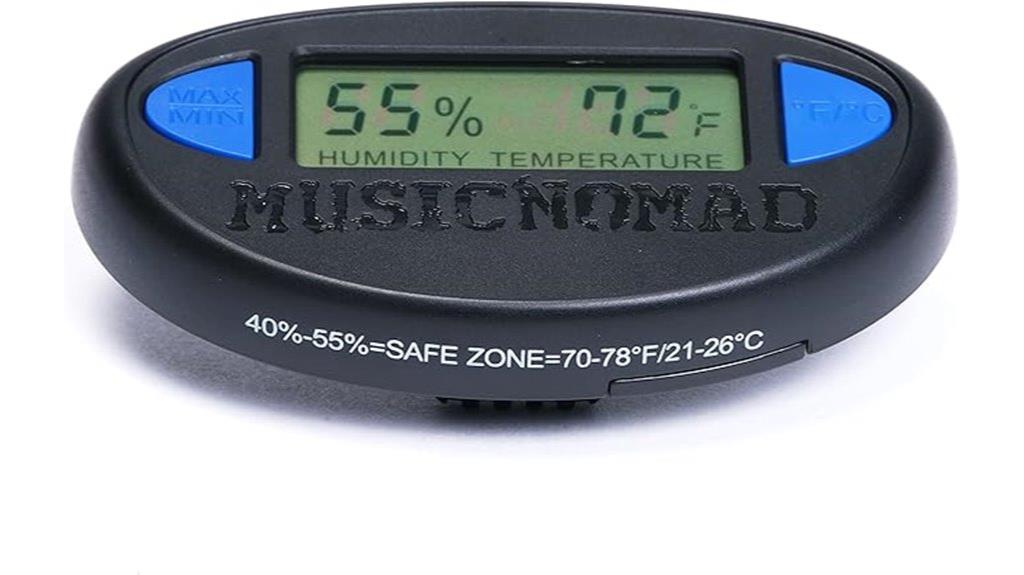
Guitar enthusiasts who obsess over precise environmental monitoring will find the MusicNomad HONE Guitar Hygrometer (MN312) particularly appealing, since it delivers continuous humidity and temperature readings every 20 seconds through its convenient clip-on design. You’ll appreciate its LCD display that tracks maximum and minimum ranges, providing alerts when conditions drift outside safe zones for your instrument. At 0.67 ounces and measuring just over three inches long, it clips securely onto acoustic or electric guitar strings without interfering with your playing. The device runs on included LR44 batteries and displays readings in both Fahrenheit and Celsius, earning a solid 4.6-star rating from users who value its accuracy.
Best For: Guitar enthusiasts who want continuous environmental monitoring to protect their instruments from humidity and temperature damage with precise, real-time readings.
Pros:
- Monitors humidity and temperature every 20 seconds with LCD display and safe zone alerts
- Lightweight clip-on design (0.67 oz) that works with both acoustic and electric guitars
- Tracks and displays maximum/minimum ranges with option to reset readings as needed
Cons:
- Lacks an on/off switch which users find inconvenient for battery conservation
- Difficult battery compartment access makes replacement challenging
- May not fit well in some guitar cases due to pressure from the lid when attached to strings
4 Pcs Acoustic Guitar Humidifier for Preventing Cracking
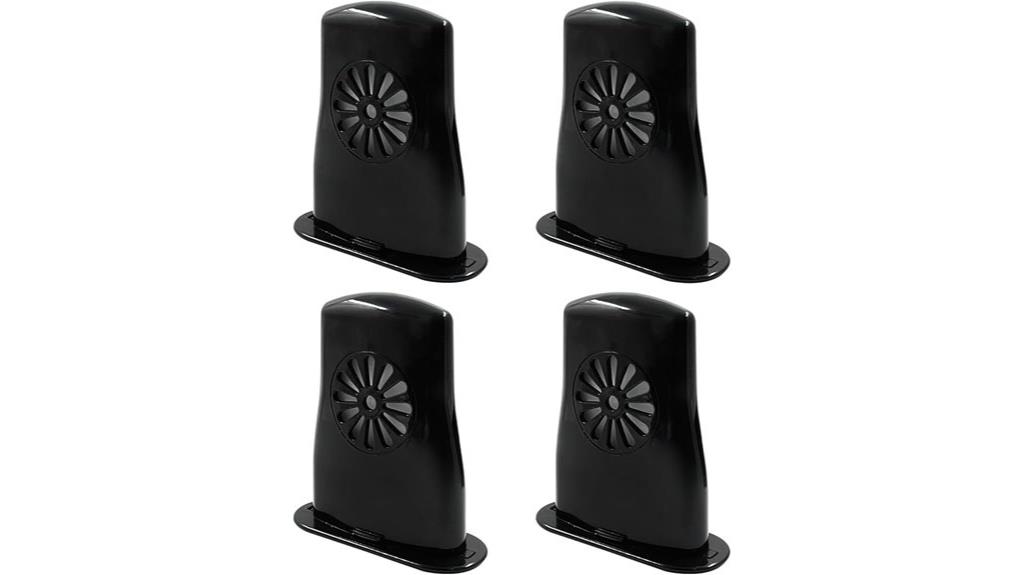
Budget-conscious guitarists who need reliable humidity protection without breaking the bank will find exceptional value in this 4-piece acoustic guitar humidifier set from Bonsicoky, which delivers practical moisture control at a fraction of the cost compared to premium alternatives. You’ll get four compact ABS plastic humidifiers that install easily on your guitar’s strings, each featuring built-in sponges that prevent leakage while maintaining moisture for approximately one week. While these won’t retain water as long as premium brands, they effectively prevent cracking, warpage, and shrinkage in dry conditions, earning 4.4 stars from users who appreciate their simplicity and effectiveness for basic guitar maintenance needs.
Best For: Budget-conscious guitarists who want affordable, reliable humidity protection for their acoustic guitars without spending premium prices.
Pros:
- Four-piece set provides excellent value with built-in sponge design that prevents leakage
- Easy installation on guitar strings with compact, lightweight design that won’t stress the instrument
- 30-day risk-free guarantee and 4.4-star rating from users who confirm effectiveness in preventing cracking and warpage
Cons:
- Retains moisture for shorter periods compared to premium brand alternatives
- Mixed user experiences with sponge durability and cleaning difficulty of the humidifier body
- Manual measurement tolerances and potential color variations due to display differences
D’Addario Acoustic Guitar Soundhole Humidifier
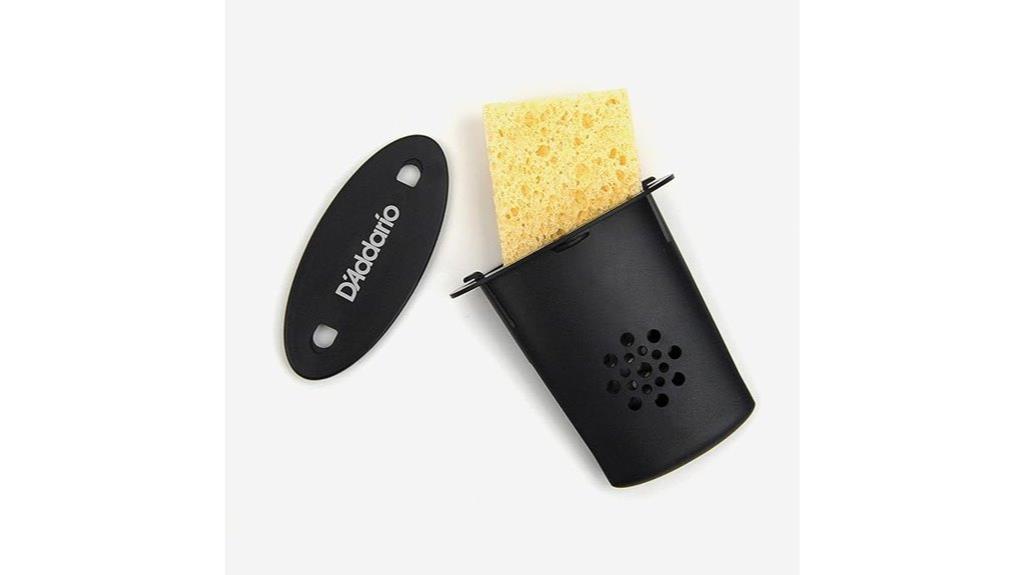
Protecting your acoustic guitar from dry conditions becomes effortless with the D’Addario Acoustic Guitar Soundhole Humidifier, a simple yet effective solution that’s earned over 4,145 customer ratings averaging 4.5 stars. This suspended design never touches your guitar’s body, releasing moisture evenly through its non-drip system that prevents warping and maintains playability during harsh winter months. You’ll simply moisten the included sponge, insert it into the housing, and hang it in your soundhole—rewetting when dry. While requiring frequent maintenance compared to two-way humidity control systems, this affordable humidifier represents solid protection from D’Addario’s two decades of manufacturing experience.
Best For: Acoustic guitar owners seeking an affordable, proven solution to protect their instruments from dry conditions and humidity-related damage during winter months or in arid climates.
Pros:
- Suspended design never touches guitar body, preventing scratches while providing even moisture distribution through non-drip system
- Simple operation with easy maintenance – just moisten sponge and insert into soundhole, rewetting when dry
- Highly rated product (4.5/5 stars, 4,145+ reviews) from experienced manufacturer with over 20 years in the industry
Cons:
- Requires frequent maintenance and regular rewetting compared to two-way humidity control systems
- Provides only one-way hydration without ability to reduce excess humidity levels
- More basic solution compared to higher-priced alternatives that offer greater convenience and efficiency
MusicNomad (MN311) The Humitar ONE-Acoustic Guitar Humidifier & Hygrometer
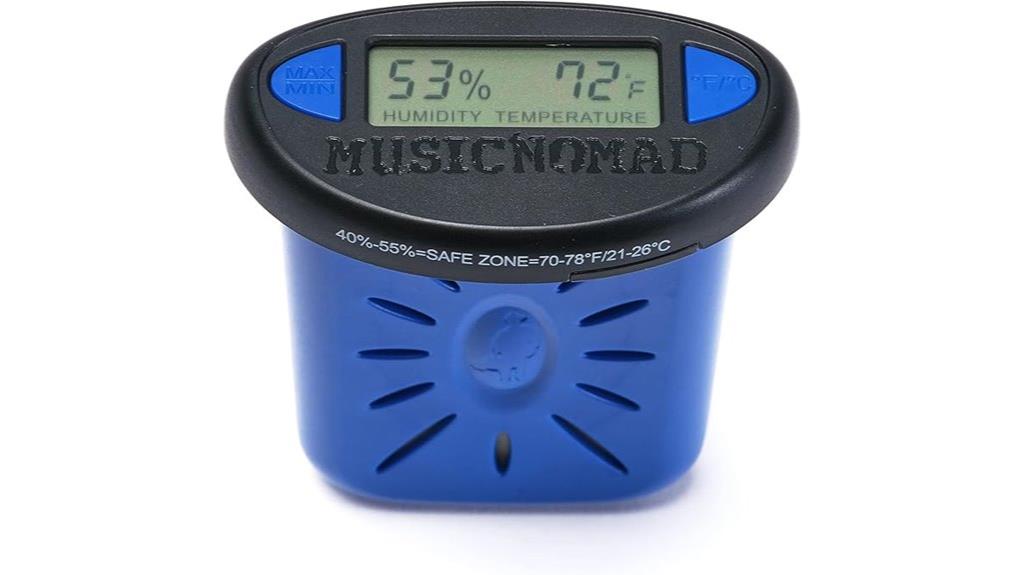
The MusicNomad MN311 Humitar ONE stands out as the best choice for guitarists who want thorough humidity monitoring without the guesswork, combining a reliable humidification system with real-time environmental tracking in one compact device. You’ll appreciate its innovative Humid-i-Bar sponge that holds substantial water, reducing your maintenance frequency while the accurate sensor updates readings every twenty seconds on a clear LCD display. I’ve found the tracking feature particularly useful, as it records maximum and minimum humidity levels over time, helping you understand your guitar’s environmental patterns. Though some users report string tension issues due to the housing design, the 4.6-star rating from 585 reviews confirms its effectiveness at maintaining ideal 45-50% humidity levels.
Best For: Guitarists who want comprehensive humidity monitoring and control in one device, especially those who prefer detailed environmental tracking with minimal maintenance requirements.
Pros:
- Combines humidification and hygrometer functions with real-time monitoring that updates every 20 seconds and tracks historical humidity patterns
- Features an innovative Humid-i-Bar sponge that retains substantial water, reducing the frequency of refills and maintenance
- Highly rated by users (4.6/5 stars) for effectively maintaining optimal humidity levels between 45-50% for acoustic guitars
Cons:
- Housing design can cause excessive tension on guitar strings, potentially affecting tuning stability
- Higher price point compared to basic humidifier alternatives without monitoring features
- Some users report occasional over-humidification issues that may require additional humidity control measures
MusicNomad Humitar Acoustic Guitar Humidifier (MN300)
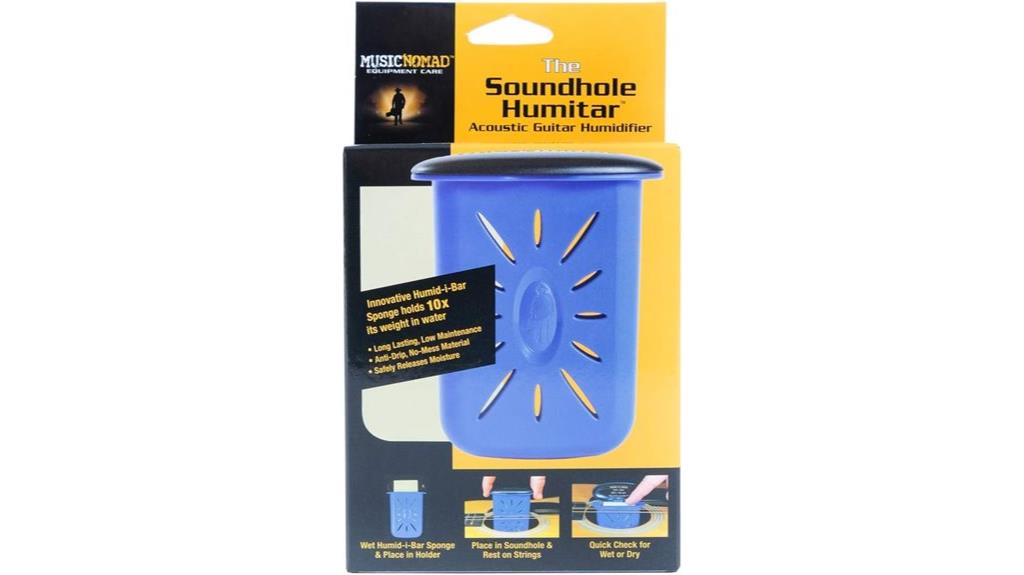
Guitar owners who’ve experienced the heartbreak of discovering cracks in their prized instruments will appreciate the MusicNomad Humitar‘s innovative approach to moisture control, which combines cutting-edge sponge technology with foolproof design elements that eliminate the guesswork from humidity maintenance. The MN300’s Humid-i-Bar sponge holds ten times its weight in water, delivering consistent moisture release while its anti-drip material prevents messy accidents that could damage your guitar’s finish. You’ll find the quick-flip top particularly convenient for checking moisture levels without removing the entire unit, and the simple string-hanging design positions the humidifier perfectly within the sound hole for ideal moisture distribution throughout your guitar’s body.
Best For: Guitar owners who want to protect their acoustic instruments from humidity-related damage like warping, shrinking, and cracking with a low-maintenance, mess-free humidification system.
Pros:
- Humid-i-Bar sponge holds 10x its weight in water for long-lasting moisture release
- Anti-drip, no-mess material protects guitar finish from water damage
- Quick-flip top allows easy moisture level checking without removal
Cons:
- Requires regular monitoring and refilling of the sponge
- Only works for acoustic guitars with sound holes
- May need frequent attention in extremely dry climates
O Oasis Humidifier for Acoustic Guitars (OH-5)
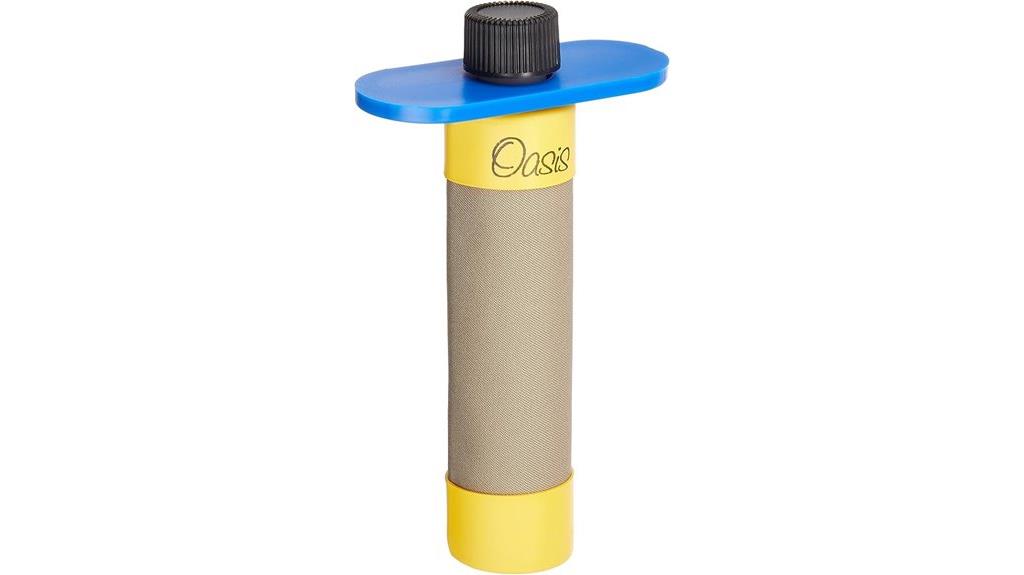
Acoustic guitar owners who live in dry climates or heat their homes during winter months will find the Oasis OH-5 Plus+ Guitar Humidifier particularly valuable, as it delivers 50% greater humidity output than its predecessor while fitting securely into standard soundholes. You’ll need to refill this humidifier every three to four days using distilled water, which prevents mineral buildup that can clog the liner. The included 10cc syringe makes precise filling straightforward, while the stabilizer bar guarantees proper mounting inside your guitar’s body. At 4.6 stars from over 1,000 reviews, users consistently report noticeable improvements in maintaining wood integrity during harsh winter conditions.
Best For: Acoustic guitar owners in dry climates or those who heat their homes during winter months and need reliable humidity protection for their instruments.
Pros:
- Delivers 50% greater humidity output than the original model, providing superior protection for guitar wood integrity
- Includes precision tools (10cc syringe and stabilizer bar) for easy filling and secure mounting in the soundhole
- Highly rated by users (4.6/5 stars from 1,000+ reviews) with consistent reports of effectiveness in harsh winter conditions
Cons:
- Requires frequent maintenance with refills needed every 3-4 days during active use
- Must use distilled water only, as tap water can clog the liner with mineral buildup
- Somewhat expensive upfront cost, though users consider it worthwhile for instrument protection
Factors to Consider When Choosing a Guitar Humidifier
When I’m helping guitarists select the right humidifier for their instruments, I focus on five critical factors that determine both effectiveness and long-term satisfaction with the device. The humidity control method, whether it’s passive evaporation or active monitoring, directly impacts how consistently your guitar maintains ideal moisture levels, while maintenance requirements can make the difference between a device you’ll actually use and one that sits forgotten in your case. Installation complexity, moisture capacity for your specific environment, and temperature monitoring capabilities round out the essential considerations that I’ve found separate mediocre humidifiers from exceptional ones.
Humidity Control Method
The humidity control method represents perhaps the most critical decision you’ll make when selecting a guitar humidifier, as it directly determines how consistently your instrument maintains ideal moisture levels throughout varying environmental conditions. I’ve found that two-way systems offer superior protection compared to traditional one-directional units, since they both absorb excess moisture during humid periods and release it when conditions become dry. While I appreciate the convenience of maintenance-free models that eliminate manual refills and constant monitoring, sponge-based humidifiers provide excellent slow, even moisture distribution with minimal leak risk. Traditional refillable units require more attention to prevent over-humidification damage, though they’re often more affordable. Regardless of your choice, always use distilled water to prevent mineral buildup that’ll clog and damage your device.
Maintenance Requirements
Although I’ve tested dozens of guitar humidifiers over the years, I can tell you that maintenance requirements often become the deciding factor between a device you’ll actually use consistently and one that’ll end up forgotten in your case. Some humidifiers demand constant attention, requiring frequent moisture level monitoring and regular refilling to maintain ideal humidity, which frankly becomes tedious after a few weeks. I prefer maintenance-free options that automatically add or remove moisture without my intervention, though these typically cost more upfront. Sponge-based models need careful attention to keep the sponge adequately soaked without over-humidifying your guitar, while others require periodic component replacement. Always check storage conditions and follow upkeep instructions to prevent leakage and extend your humidifier’s lifespan.
Installation and Placement
Placement decisions can make or break your humidification efforts, and I’ve learned this lesson through countless trial-and-error moments with different guitar setups over the years. When selecting a humidifier, I always consider the installation method first, as sound hole models differ greatly from string-hanging designs regarding space requirements and ease of use. I’ve made the mistake of choosing humidifiers that obstruct the sound hole, which noticeably affected my guitar’s audio quality during practice sessions. Case limitations matter too; I verify the humidifier fits without creating pressure points that throw off tuning stability. Regular position monitoring becomes essential since movement reduces effectiveness, and I strictly follow manufacturer placement guidelines for best moisture distribution throughout the guitar body.
Moisture Capacity
Once you’ve nailed down proper placement, moisture capacity becomes your next major consideration, and I can’t stress enough how this single factor determines whether you’ll be refilling your humidifier every few days or every few weeks. Higher-capacity units sustain humidity levels longer, which means less maintenance and more consistent protection for your guitar’s wood. I’ve found that sponge-type materials and specialized absorbent fabrics make all the difference in how evenly moisture releases into your guitar case’s environment. Temperature and existing humidity levels will affect performance, so you’ll need to monitor your instrument regardless of capacity. Guitar-specific designs often include precise moisture control features that prevent the over-humidification damage I’ve unfortunately witnessed too many times.
Temperature Monitoring Features
While moisture capacity keeps your humidifier running longer between refills, temperature monitoring features transform your humidity system from a basic moisture source into a thorough environmental protection system for your guitar. I’ve discovered that temperature fluctuations cause wood expansion and contraction, creating stress that can damage your instrument’s structure, finish, and playability. The best humidifiers include integrated hygrometers that track both temperature and humidity simultaneously, giving you real-time environmental data that’s essential for making informed decisions about when to activate additional protection measures. I particularly value models with programmable alerts that warn you when temperatures reach unsafe ranges, because catching these conditions early prevents costly repairs and maintains your guitar’s peak performance year-round.
Case Compatibility
Before you purchase any guitar humidifier, I’ve learned that case compatibility determines whether your investment becomes a reliable protection system or a frustrating source of instrument damage. I always measure my case’s interior dimensions first, ensuring the humidifier won’t create pressure points against my guitar’s body or neck when closed. The installation mechanism matters greatly—I prefer soundhole models over string-suspended designs because they typically offer better case clearance and won’t shift during transport. I’ve discovered that checking airflow patterns within closed cases prevents moisture stagnation, while verifying secure positioning prevents the humidifier from rattling around and potentially scratching my instrument’s finish during movement or storage.
Durability and Materials
Through years of testing various guitar humidifiers, I’ve found that material selection directly determines whether your humidifier will last multiple seasons or require replacement after just a few months of use. ABS plastic consistently outperforms other materials, offering exceptional durability that withstands daily handling without cracking or warping. I’ve noticed non-vinyl, non-allergenic resins resist wear considerably better than cheaper alternatives, though they cost more upfront. The structural design matters equally—humidifiers with reinforced construction maintain moisture levels more effectively, preventing the frustrating cycle of over and under-humidification that plagues poorly built units. Even premium materials require regular maintenance to prevent mineral buildup, which I’ve learned can compromise function regardless of construction quality.
Price and Value
After evaluating dozens of guitar humidifiers across every price point, I’ve discovered that spending between $20-35 typically delivers the sweet spot where quality construction meets reasonable longevity, though I’ll admit my wallet initially resisted this logic when $10 options seemed perfectly adequate. Those budget models often require replacement every 2-3 months, while mid-range options frequently last 4-6 months before needing attention. I’ve learned that advanced features like two-way humidity control, found in higher-priced models exceeding $50, can justify their cost through enhanced convenience and reduced maintenance frequency. When I consider potential repair bills from humidity damage—often hundreds of dollars—investing in quality humidification becomes a no-brainer for protecting valuable instruments.
On a final note
I’ve covered the essential guitar humidifiers that’ll keep your instrument stable through seasonal changes, from D’Addario’s automated two-way system to traditional soundhole models like the Oasis OH-5. While I can’t guarantee which one suits your specific climate or guitar type, these options represent proven solutions that countless musicians rely on. Remember, consistent humidity matters more than perfect readings, and even basic humidifiers beat neglecting your guitar entirely during dry months.


